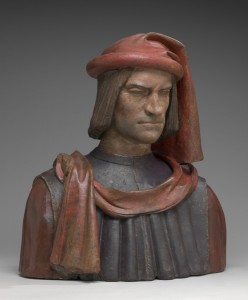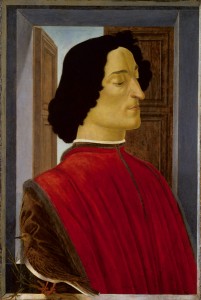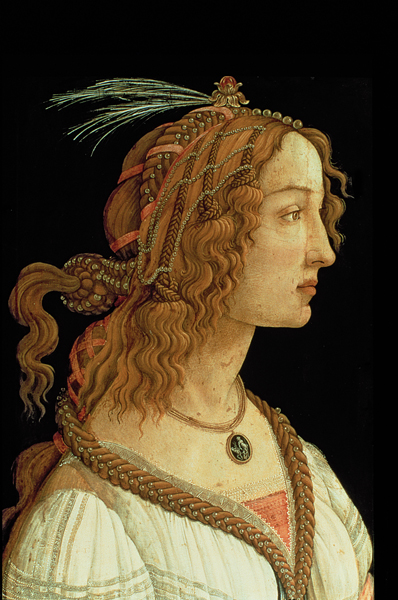In 1860 the first great historian of the Italian Renaissance, Jacob Burckhardt, called the period the “golden age of bastards” and the “age of golden bastards.”11 Powerful men routinely took many mistresses and fathered many children with them, not a few of whom went on to brilliant careers. Federigo da Montefeltro, Sigismondo Malatesta, Lionello d’Este—all were bastard children, as was Leonardo da Vinci. But this period, when genealogies were swelled by illegitimate offspring, was also a time when an idealized and chaste version of courtly love, cast in terms of humanist philosophy, found intense and eloquent expression. In this section we look at lovers, platonic and otherwise.

Florentine 15th or 16th century, probably after a model by Andrea del Verrocchio and Orsino Benintendi
Lorenzo de’ Medici, 1478/1521
Painted terra-cotta, 65.8 x 59.1 x 32.7 cm (25 7/8 x 23 1/4 x 12 7/8 in.)
National Gallery of Art, Washington, DC, Samuel H. Kress Collection
Image courtesy of the Board of Trustees, National Gallery of Art
Princely infidelity was not a personal secret but part of a political dynamic and an accepted norm. No scandal whatsoever attached to the man—perhaps the opposite, in fact. Women had no real choice in the matter. The mistress of a powerful prince was a common, and unremarkable, presence at court; the current prima favorita, married or not, was openly acknowledged, even honored. In many cases she enjoyed a degree of independence not available to other women, including, notably, her lover’s wife. Many of the women’s families also found the arrangement to their advantage, politically and financially. Today we are somewhat startled to find mistresses celebrated for their virtue—but virtue was simply the most important coin of female excellence, and it was defined by men. If mistresses were not chaste in our sense of the word, it is, however, safe to assume that a prudent mistress took great care to remain faithful to a powerful lord.
Some mistresses of powerful men played quite influential roles, shaping the tenor of the court as much or more than did wives. Their children, some of whom eventually succeeded to the father’s title, were mostly untainted by the circumstances of their birth. “Natural” children were frequently raised by the legal wife, alongside half brothers and sisters; others were sent to live and be educated in foreign courts. Generally speaking, the higher the status of a mistress’s own family, the higher the status enjoyed by her illegitimate children. Although some of these offspring were legitimated by papal decree, that legal nicety was not necessary to their advancement.
The “shelf life” of a mistress was often short, and even during the course of an affair the man’s favor was often not exclusive. Former mistresses might return to their husbands, be married off to members of the lesser nobility, or enter a convent. Powerful rulers’ wives, if they took lovers, found themselves in a wholly different position. Some were executed; at least one woman is known to have been imprisoned and left to starve. Punishment was also harsh for the offending man.

Sandro Botticelli
Giuliano de’ Medici, c. 1478/80
Tempera on panel, 75.5 x 52.5 cm (29 3/4 x 20 11/16 in.)
National Gallery of Art, Washington, DC, Samuel H. Kress Collection
Image courtesy of the Board of Trustees, National Gallery of Art
The situation, however, was quite different if the affair was of platonic love—existing, even exalted, within the rarified intellectual atmosphere of Renaissance humanism. These passionate but nonphysical liaisons occurred between men of learning and the wives or daughters of prominent families. Celebrated with the trappings of medieval courtly romance, the affairs were a source of intense public interest and enthusiastic approval, particularly in Florence, where the Medici set a powerful example. Lorenzo de’ Medici declared Lucrezia Donati as his platonic love, and his younger brother Giuliano devoted himself to Simonetta Vespucci. Both women, married to others, were honored by jousts and extolled by poets. The devotion of Florentine men to unattainable women harked back to a chivalric ideal in which vassal knights cemented their allegiance to a lord through their attachment to the lord’s lady. Gifts, rapturous praise, and poems dedicated to the elevating power of love were exchanged between couples and shared within a wider humanist circle. These were not private affairs but rather, the talk of the town. When Simonetta died tragically young—in 1476, when she was perhaps twenty-three—the entire city seemed to partake in Giuliano’s grief.
Botticelli’s Idealized Beauty

Sandro Botticelli
Young Woman (Simonetta Vespucci?) in Mythological Guise, c. 1480
Tempera on panel, 81.5 x 54.2 cm (32 1/16 x 21 5/16 in.)
Städelsches Kunstinstitut, Frankfurt am Main
The Bridgeman Art Library
Botticelli’s idealized beauty in this painting is linked to Simonetta Vespucci because the ancient cameo she wears was in the Medici collection and the pearl net in her hair, called a vespaio (wasp’s nest), puns her surname. The image is probably guided more by a notion of perfection than her actual appearance.
Marsilio Ficino
“Whoever considers the matter carefully will find that the true definition of love is the appetite for beauty.”
—Marsilio Ficino13
The affairs were informed by Neoplatonic philosophy, which saw beauty, physical and moral, as a way to apprehend the divine. Platonic love—the term was coined by Florentine philosopher Marsilio Ficino—stirred the soul toward God. Love was spurred by the sight of beauty and the knowledge of virtue, propelling the lover along a spiritual quest. Platonic love affairs were another expression of the philosophical aspirations of humanist culture, and the women who were the object of those passions were, like the men, well versed in literature and philosophy—indeed, such a rarified sort of love more or less required partners who could share intellectually in its delights. It was a rather bloodless kind of ardor. When poets spoke of “love,” the word was most often a noun; even when “love” was used as a verb it rarely had an object—one loved, one did not love someone. The general grief that descended on the whole of Florence when Simonetta died suggests a pervasive cult of love rather than an individual or deeply emotional attachment.